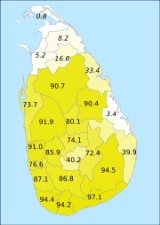
Demographics of Sri Lanka
Encyclopedia
This article is about the demographic
features of the population
of Sri Lanka
, including population density
, ethnicity
, education level, health of the populace, economic status, religious affiliations and other aspects of the population.
Sri Lanka
is an island in the Indian Ocean
also called Ceylon and many other names. It is about 28 kilometers (18 mi.) off the southeastern coast of India
with a population of about 20 million. Density is highest in the southwest where Colombo
, the country's main port and industrial center, is located. The net population growth is about 0,7%. Sri Lanka is ethnically, linguistically, and religiously diverse.
, an Indo-Aryan
group make up 73.8% of the population (according to 1981 census) and are concentrated in the densely populated southwest and central parts of the Island. The Sri Lanka Tamils, a Dravidian
group, live predominantly in the northeast of the island forming the largest minority group at 12.6% (according to the 1981 census) of the population. The Sri Lankan population after 1981 census are based on estimations given that large areas of northern Sri Lanka were under LTTE control and that large numbers of Tamils have fled abroad. See Sri Lankan Tamil diaspora
.
There are also Indian Tamils who form distinct ethnic group which comprises 5.1% of the population. The British brought them to Sri Lanka in the 19th century as tea and rubber plantation workers, and they remain concentrated in the "tea country" of south-central Sri Lanka. In accordance with a 1964 agreement with India, Sri Lanka granted citizenship to 230,000 "stateless" Indian Tamils in 1988. Under the pact, India granted citizenship to the remainder, some 200,000 of whom now live in India. Another 75,000 Indian Tamils, who themselves or whose parents once applied for Indian citizenship, now wish to remain in Sri Lanka. The government has stated these Tamils will not be forced to return to India, although they are not technically citizens of Sri Lanka.
The Moors
, who descend from Arab traders that settled in Sri Lanka, form the third largest ethnic group at 7.2% of the population. They are mostly concentrated in urban areas in the southern parts of the island with substantial populations in the Central and Eastern
provinces. During times of Portuguese colonization, Moors
were persecuted, and many forced to retreat to the central highlands and the eastern coast.
Smaller minorities include the Malay
s who descent from South East Asian settlers, and the Burgher
s, who are descendants of European
colonists, principally from Portugal
, the Netherlands
and the UK
.
Some one edited this and the numbers are wrong. Please visit Sri Lanka government web site for correct information
Population of Sri Lanka by ethnic group 1881 to 2001
1 Indian Tamils were only classified as a separate ethnic group from 1911 onwards. Prior to this they were included with Sri Lankan Tamils. 2 2001 Census was only carried out in 18 of the 25 districts
. Inclusion of data would be misleading.
. The Malays
and Moors
are Muslim. Sizable minorities of both Sinhalese and Tamils are Christian
s, most of whom are Roman Catholic. The Burgher
population is mostly Roman Catholic or Presbyterian. The Veddahs have Animist and Buddhist practices. The 1978 constitution, while assuring freedom of religion, grants primacy to Buddhism.
Population of Sri Lanka by religion 1881 to 2001
1 2001 Census was only carried out in 18 of the 25 districts
. Inclusion of data would be misleading.
, a Dravidian
language. The Moors
speak an Arab-Tamil dialect, consisting of a large number of Arabic words while The Malays speak Sri Lanka Malay
. Many of the Burghers
speak Sri Lankan Indo-Portuguese
although its use has declined and all speak Sinhala. The Veddahs speak a language closely related to Sinhala. Use of English
has declined since independence, but it continues to be spoken by many in the middle and upper middle classes, particularly in Colombo. The government is seeking to reverse the decline in the use of English, mainly for economic but also for political reasons. Both Sinhala and Tamil are official languages.
Population
21,513,990
note:
since the outbreak of hostilities between the government and armed Tamil separatists in the mid-1980s, several hundred thousand Tamil civilians have fled the island and more than 200,000 Tamils have sought refuge in the West (July 2010 est.)
0–14 years:
26% (male 2,605,251; female 2,490,416)
15–64 years:
67% (male 6,285,118; female 6,606,196)
65 years and over:
7% (male 602,470,000; female 649,124,000) (2000 est.)
0-14 years:
23.9% (male 2,594,815/female 2,493,002)
15-64 years:
68% (male 7,089,307/female 7,418,123)
65 years and over:
8.1% (male 803,172/female 926,372) (2010 est.)
Birth rate
16.79 births/1,000 population (2000 est.)
15.88 births/1,000 population (2010 est.)
Death
6.43 deaths/1,000 population (2000 est.)
6.2 deaths/1,000 population (2010 est.)
at birth:
1.05 male(s)/female
under 15 years:
1.05 male(s)/female
15–64 years:
0.95 male(s)/female
65 years and over:
0.93 male(s)/female
total population:
0.97 male(s)/female (2000 est.)
Infant mortality
16.51 deaths/1,000 live births (2000 est.)
18.14 deaths/1,000 live births (2010 est.)
Life expectancy
total population:
75.3 years
male:
73.22 years
female:
77.47 years (2010 est.)
Total fertility
1.98 children born/woman (2000 est.)
1.96 children born/woman (2010 est.)
Ethnic group
Sinhalese
73.8%, Sri Lankan Tamil 13.9%, Sri Lankan Moors
7.2%, Indian Tamil 4.6%, Others Burgher
, Sri Lankan Malay
, and Veddah 0.5%,
These figures are based on the 2001 census which was only carried out partially in the Northern
and Eastern
provinces, where the majority of Sri Lankan Tamils live. Therefore the Sri Lankan Tamil percentage is grossly understated. The Sri Lankan government estimates that the Tamils (Sri Lankan and Indian) account for 18% of the population.
Religion
Buddhism
69.1%, Islam
7.6%, Hinduism
7.1%, Christianity
6.2%, unspecified 10% (2001 census provisional data)
Language
Sinhala (official
and national language
) 74%, Tamil
(official
and national language
) 18%
note:
English
is commonly used in government and is spoken competently by about 40% of the population
Literacy
definition:
age 15 and over can read and write
total population:
90.7%
male:
92.3%
female:
89.1% (2001 est.)
https://www.cia.gov/library/publications/the-world-factbook/geos/ce.html
Demographics
Demographics are the most recent statistical characteristics of a population. These types of data are used widely in sociology , public policy, and marketing. Commonly examined demographics include gender, race, age, disabilities, mobility, home ownership, employment status, and even location...
features of the population
Population
A population is all the organisms that both belong to the same group or species and live in the same geographical area. The area that is used to define a sexual population is such that inter-breeding is possible between any pair within the area and more probable than cross-breeding with individuals...
of Sri Lanka
Sri Lanka
Sri Lanka, officially the Democratic Socialist Republic of Sri Lanka is a country off the southern coast of the Indian subcontinent. Known until 1972 as Ceylon , Sri Lanka is an island surrounded by the Indian Ocean, the Gulf of Mannar and the Palk Strait, and lies in the vicinity of India and the...
, including population density
Population density
Population density is a measurement of population per unit area or unit volume. It is frequently applied to living organisms, and particularly to humans...
, ethnicity
Ethnic group
An ethnic group is a group of people whose members identify with each other, through a common heritage, often consisting of a common language, a common culture and/or an ideology that stresses common ancestry or endogamy...
, education level, health of the populace, economic status, religious affiliations and other aspects of the population.
Sri Lanka
Sri Lanka
Sri Lanka, officially the Democratic Socialist Republic of Sri Lanka is a country off the southern coast of the Indian subcontinent. Known until 1972 as Ceylon , Sri Lanka is an island surrounded by the Indian Ocean, the Gulf of Mannar and the Palk Strait, and lies in the vicinity of India and the...
is an island in the Indian Ocean
Indian Ocean
The Indian Ocean is the third largest of the world's oceanic divisions, covering approximately 20% of the water on the Earth's surface. It is bounded on the north by the Indian Subcontinent and Arabian Peninsula ; on the west by eastern Africa; on the east by Indochina, the Sunda Islands, and...
also called Ceylon and many other names. It is about 28 kilometers (18 mi.) off the southeastern coast of India
India
India , officially the Republic of India , is a country in South Asia. It is the seventh-largest country by geographical area, the second-most populous country with over 1.2 billion people, and the most populous democracy in the world...
with a population of about 20 million. Density is highest in the southwest where Colombo
Colombo
Colombo is the largest city of Sri Lanka. It is located on the west coast of the island and adjacent to Sri Jayawardenapura Kotte, the capital of Sri Lanka. Colombo is often referred to as the capital of the country, since Sri Jayawardenapura Kotte is a satellite city of Colombo...
, the country's main port and industrial center, is located. The net population growth is about 0,7%. Sri Lanka is ethnically, linguistically, and religiously diverse.
People
SinhaleseSinhalese people
The Sinhalese are an Indo-Aryan ethnic group,forming the majority of Sri Lanka,constituting 74% of the Sri Lankan population.They number approximately 15 million worldwide.The Sinhalese identity is based on language, heritage and religion. The Sinhalese speak Sinhala, an Indo-Aryan language and the...
, an Indo-Aryan
Indo-Aryans
Indo-Aryan is an ethno-linguistic term referring to the wide collection of peoples united as native speakers of the Indo-Aryan branch of the Indo-Iranian family of Indo-European languages...
group make up 73.8% of the population (according to 1981 census) and are concentrated in the densely populated southwest and central parts of the Island. The Sri Lanka Tamils, a Dravidian
Dravidian peoples
Dravidian peoples is a term used to refer to the diverse groups of people who natively speak languages belonging to the Dravidian language family. Populations of speakers of around 220 million are found mostly in Southern India. Other Dravidian people are found in parts of central India, Sri Lanka,...
group, live predominantly in the northeast of the island forming the largest minority group at 12.6% (according to the 1981 census) of the population. The Sri Lankan population after 1981 census are based on estimations given that large areas of northern Sri Lanka were under LTTE control and that large numbers of Tamils have fled abroad. See Sri Lankan Tamil diaspora
Sri Lankan Tamil diaspora
The Sri Lankan Tamil Diaspora refers to the global diaspora of the people of Sri Lankan Tamil origin. It can be said to be a subset of the larger Sri Lankan as well as Tamil diaspora....
.
There are also Indian Tamils who form distinct ethnic group which comprises 5.1% of the population. The British brought them to Sri Lanka in the 19th century as tea and rubber plantation workers, and they remain concentrated in the "tea country" of south-central Sri Lanka. In accordance with a 1964 agreement with India, Sri Lanka granted citizenship to 230,000 "stateless" Indian Tamils in 1988. Under the pact, India granted citizenship to the remainder, some 200,000 of whom now live in India. Another 75,000 Indian Tamils, who themselves or whose parents once applied for Indian citizenship, now wish to remain in Sri Lanka. The government has stated these Tamils will not be forced to return to India, although they are not technically citizens of Sri Lanka.
The Moors
Sri Lankan Moors
The Sri Lankan Moors are the third largest ethnic group in Sri Lanka comprising 8% of the country's total population . They are predominantly followers of Islam. The Moors trace their ancestry to Arab traders who settled in Sri Lanka some time between the 8th and 15th centuries...
, who descend from Arab traders that settled in Sri Lanka, form the third largest ethnic group at 7.2% of the population. They are mostly concentrated in urban areas in the southern parts of the island with substantial populations in the Central and Eastern
Eastern Province, Sri Lanka
The Eastern Province is one of the 9 provinces of Sri Lanka. The provinces have existed since the 19th century but they didn't have any legal status until 1987 when the 13th Amendment to the 1978 Constitution of Sri Lanka established provincial councils. Between 1988 and 2006 the province was...
provinces. During times of Portuguese colonization, Moors
Sri Lankan Moors
The Sri Lankan Moors are the third largest ethnic group in Sri Lanka comprising 8% of the country's total population . They are predominantly followers of Islam. The Moors trace their ancestry to Arab traders who settled in Sri Lanka some time between the 8th and 15th centuries...
were persecuted, and many forced to retreat to the central highlands and the eastern coast.
Smaller minorities include the Malay
Sri Lankan Malays
The Malays of Sri Lanka originated in Southeast Asia and today consist of about 50,000 people...
s who descent from South East Asian settlers, and the Burgher
Burgher people
The Burghers are a Eurasian ethnic group, historically from Sri Lanka, consisting for the most part of male-line descendants of European colonists from the 16th to 20th centuries and local women, with some minorities of Swedish, Norwegian, French and Irish.Today the mother tongue of the Burghers...
s, who are descendants of European
European ethnic groups
The ethnic groups in Europe are the various ethnic groups that reside in the nations of Europe. European ethnology is the field of anthropology focusing on Europe....
colonists, principally from Portugal
Portugal
Portugal , officially the Portuguese Republic is a country situated in southwestern Europe on the Iberian Peninsula. Portugal is the westernmost country of Europe, and is bordered by the Atlantic Ocean to the West and South and by Spain to the North and East. The Atlantic archipelagos of the...
, the Netherlands
Netherlands
The Netherlands is a constituent country of the Kingdom of the Netherlands, located mainly in North-West Europe and with several islands in the Caribbean. Mainland Netherlands borders the North Sea to the north and west, Belgium to the south, and Germany to the east, and shares maritime borders...
and the UK
United Kingdom
The United Kingdom of Great Britain and Northern IrelandIn the United Kingdom and Dependencies, other languages have been officially recognised as legitimate autochthonous languages under the European Charter for Regional or Minority Languages...
.
| Sinhalese [%] | Native Tamils [%] | Tamils of Indian origin [%] | Moors [%] | Burghers [%] |
|---|---|---|---|---|
 |
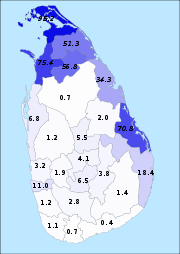 |
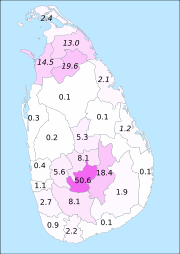 |
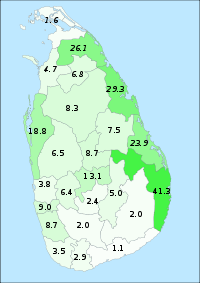 |
 |
| Major ethnic groups in Sri Lanka. The percentages shown are from 2001 or 1981 (cursive) census. | ||||
Some one edited this and the numbers are wrong. Please visit Sri Lanka government web site for correct information
Population of Sri Lanka by ethnic group 1881 to 2001
| Year | Sinhalese Sinhalese people The Sinhalese are an Indo-Aryan ethnic group,forming the majority of Sri Lanka,constituting 74% of the Sri Lankan population.They number approximately 15 million worldwide.The Sinhalese identity is based on language, heritage and religion. The Sinhalese speak Sinhala, an Indo-Aryan language and the... |
Sri Lankan Tamil1 | Indian Tamil1 | Sri Lankan Moor Sri Lankan Moors The Sri Lankan Moors are the third largest ethnic group in Sri Lanka comprising 8% of the country's total population . They are predominantly followers of Islam. The Moors trace their ancestry to Arab traders who settled in Sri Lanka some time between the 8th and 15th centuries... |
Others | Total | ||||||
|---|---|---|---|---|---|---|---|---|---|---|---|---|
| No. | % | No. | % | No. | % | No. | % | No. | % | No. | % | |
| 1881 Census | 1,846,600 | 66.91% | 687,200 | 24.90% | 184,500 | 6.69% | 41,400 | 1.50% | 2,759,700 | 100.00% | ||
| 1891 Census | 2,041,200 | 67.86% | 723,900 | 24.07% | 197,200 | 6.56% | 45,500 | 1.51% | 3,007,800 | 100.00% | ||
| 1901 Census | 2,330,800 | 65.36% | 951,700 | 26.69% | 228,000 | 6.39% | 55,500 | 1.56% | 3,566,000 | 100.00% | ||
| 1911 Census | 2,715,500 | 66.13% | 528,000 | 12.86% | 531,000 | 12.93% | 233,900 | 5.70% | 98,000 | 2.39% | 4,106,400 | 100.00% |
| 1921 Census | 3,016,200 | 67.05% | 517,300 | 11.50% | 602,700 | 13.40% | 251,900 | 5.60% | 110,600 | 2.46% | 4,498,600 | 100.00% |
| 1931 Estimate | 3,473,000 | 65.45% | 598,900 | 11.29% | 818,500 | 15.43% | 289,600 | 5.46% | 126,000 | 2.37% | 5,306,000 | 100.00% |
| 1946 Census | 4,620,500 | 69.41% | 733,700 | 11.02% | 780,600 | 11.73% | 373,600 | 5.61% | 148,900 | 2.24% | 6,657,300 | 100.00% |
| 1953 Census | 5,616,700 | 69.36% | 884,700 | 10.93% | 974,100 | 12.03% | 464,000 | 5.73% | 158,400 | 1.96% | 8,097,900 | 100.00% |
| 1963 Census | 7,512,900 | 71.00% | 1,164,700 | 11.01% | 1,123,000 | 10.61% | 626,800 | 5.92% | 154,600 | 1.46% | 10,582,000 | 100.00% |
| 1971 Census | 9,131,300 | 71.96% | 1,424,000 | 11.22% | 1,174,900 | 9.26% | 828,300 | 6.53% | 131,400 | 1.04% | 12,689,900 | 100.00% |
| 1981 Census | 10,979,400 | 73.95% | 1,886,900 | 12.71% | 818,700 | 5.51% | 1,046,900 | 7.05% | 114,900 | 0.77% | 14,846,800 | 100.00% |
| 1989 Estimate | 12,437,000 | 73.92% | 2,124,000 | 12.62% | 873,000 | 5.19% | 1,249,000 | 7.42% | 142,000 | 0.84% | 16,825,000 | 100.00% |
| 2001 Census2 | ||||||||||||
| Sources: | ||||||||||||
1 Indian Tamils were only classified as a separate ethnic group from 1911 onwards. Prior to this they were included with Sri Lankan Tamils. 2 2001 Census was only carried out in 18 of the 25 districts
Districts of Sri Lanka
In Sri Lanka, districts are the second-level administrative divisions, and are included in a province. There are 25 districts organized into 9 provinces. Each district is administered under a District Secretary, who is appointed by the central government...
. Inclusion of data would be misleading.
Religion
Most Sinhalese are Buddhist; most Tamils are HinduHindu
Hindu refers to an identity associated with the philosophical, religious and cultural systems that are indigenous to the Indian subcontinent. As used in the Constitution of India, the word "Hindu" is also attributed to all persons professing any Indian religion...
. The Malays
Sri Lankan Malays
The Malays of Sri Lanka originated in Southeast Asia and today consist of about 50,000 people...
and Moors
Sri Lankan Moors
The Sri Lankan Moors are the third largest ethnic group in Sri Lanka comprising 8% of the country's total population . They are predominantly followers of Islam. The Moors trace their ancestry to Arab traders who settled in Sri Lanka some time between the 8th and 15th centuries...
are Muslim. Sizable minorities of both Sinhalese and Tamils are Christian
Christian
A Christian is a person who adheres to Christianity, an Abrahamic, monotheistic religion based on the life and teachings of Jesus of Nazareth as recorded in the Canonical gospels and the letters of the New Testament...
s, most of whom are Roman Catholic. The Burgher
Burgher people
The Burghers are a Eurasian ethnic group, historically from Sri Lanka, consisting for the most part of male-line descendants of European colonists from the 16th to 20th centuries and local women, with some minorities of Swedish, Norwegian, French and Irish.Today the mother tongue of the Burghers...
population is mostly Roman Catholic or Presbyterian. The Veddahs have Animist and Buddhist practices. The 1978 constitution, while assuring freedom of religion, grants primacy to Buddhism.
| Buddhism [70%] | Hinduism [15%] | Islam [7.5%] | Christianity [7.5%] |
|---|---|---|---|
 |
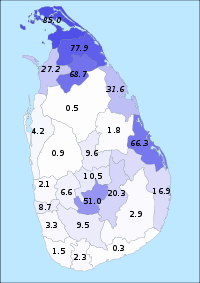 |
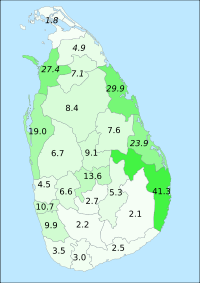 |
 |
| Distribution of the four major denominations in Sri Lanka. The percentages shown are from 2001 census except where the numbers are cursive, which are from 1981 census. Population movements have occurred after 1981, but accurate statistics do not exist for these districts. | |||
Population of Sri Lanka by religion 1881 to 2001
| Year | Buddhist | Hindu Hinduism in Sri Lanka Hindus currently make up more than 15% of the Sri Lankan population, and are almost exclusively Tamils apart from small immigrant communities from India and Pakistan such as the Sindhis, Telugus, Kannadigas and Malayalees. In the 1915 census they made up almost 25% of the population, which included... |
Muslim Islam in Sri Lanka Islam in Sri Lanka is practiced by a group of minorities who make up approximately 10% of the population.on the 2001 census of GOSL shows there are 1,711,000 Muslims The Muslim community is divided into three main ethnic groups: the Sri Lankan Moors, the Indian Muslims, and the Malays, each with... |
Christian Christianity in Sri Lanka Christianity is a minority religion in Sri Lanka. Roman Catholicism was introduced by the Portuguese in 1505. There were conversions by Dutch persons in the 17th century, which resulted in a percentage of church members in excess of 10%. This figure decreased... |
Others | Total | ||||||
|---|---|---|---|---|---|---|---|---|---|---|---|---|
| No. | % | No. | % | No. | % | No. | % | No. | % | No. | % | |
| 1881 Census | 1,698,100 | 61.53% | 593,600 | 21.51% | 197,800 | 7.17% | 268,000 | 9.71% | 2,300 | 0.08% | 2,759,800 | 100.00% |
| 1891 Census | 1,877,000 | 62.40% | 615,900 | 20.48% | 212,000 | 7.05% | 302,100 | 10.04% | 800 | 0.03% | 3,007,800 | 100.00% |
| 1901 Census | 2,141,400 | 60.06% | 826,800 | 23.19% | 246,100 | 6.90% | 349,200 | 9.79% | 2,500 | 0.07% | 3,566,000 | 100.00% |
| 1911 Census | 2,474,200 | 60.25% | 938,300 | 22.85% | 283,600 | 6.91% | 409,200 | 9.96% | 1,100 | 0.03% | 4,106,400 | 100.00% |
| 1921 Census | 2,769,800 | 61.57% | 982,100 | 21.83% | 302,500 | 6.72% | 443,400 | 9.86% | 800 | 0.02% | 4,498,600 | 100.00% |
| 1931 Estimate | 3,266,600 | 61.55% | 1,166,900 | 21.99% | 354,200 | 6.67% | 518,100 | 9.76% | 1,100 | 0.02% | 5,306,900 | 100.00% |
| 1946 Census | 4,294,900 | 64.51% | 1,320,400 | 19.83% | 436,600 | 6.56% | 603,200 | 9.06% | 2,200 | 0.03% | 6,657,300 | 100.00% |
| 1953 Census | 5,209,400 | 64.33% | 1,610,500 | 19.89% | 541,500 | 6.69% | 724,400 | 8.95% | 12,100 | 0.15% | 8,097,900 | 100.00% |
| 1963 Census | 7,003,300 | 66.18% | 1,958,400 | 18.51% | 724,000 | 6.84% | 884,900 | 8.36% | 11,400 | 0.11% | 10,582,000 | 100.00% |
| 1971 Census | 8,536,800 | 67.27% | 2,238,600 | 17.64% | 901,700 | 7.11% | 1,004,300 | 7.91% | 8,400 | 0.07% | 12,689,800 | 100.00% |
| 1981 Census | 10,288,300 | 69.30% | 2,297,800 | 15.48% | 1,121,700 | 7.56% | 1,130,600 | 7.62% | 8,300 | 0.06% | 14,846,700 | 100.00% |
| 2001 Census1 | ||||||||||||
| Source: | ||||||||||||
1 2001 Census was only carried out in 18 of the 25 districts
Districts of Sri Lanka
In Sri Lanka, districts are the second-level administrative divisions, and are included in a province. There are 25 districts organized into 9 provinces. Each district is administered under a District Secretary, who is appointed by the central government...
. Inclusion of data would be misleading.
Languages
Sinhala, an Indo-European language, is the native tongue of the Sinhalese. Tamils speak TamilTamil language
Tamil is a Dravidian language spoken predominantly by Tamil people of the Indian subcontinent. It has official status in the Indian state of Tamil Nadu and in the Indian union territory of Pondicherry. Tamil is also an official language of Sri Lanka and Singapore...
, a Dravidian
Dravidian languages
The Dravidian language family includes approximately 85 genetically related languages, spoken by about 217 million people. They are mainly spoken in southern India and parts of eastern and central India as well as in northeastern Sri Lanka, Pakistan, Nepal, Bangladesh, Afghanistan, Iran, and...
language. The Moors
Sri Lankan Moors
The Sri Lankan Moors are the third largest ethnic group in Sri Lanka comprising 8% of the country's total population . They are predominantly followers of Islam. The Moors trace their ancestry to Arab traders who settled in Sri Lanka some time between the 8th and 15th centuries...
speak an Arab-Tamil dialect, consisting of a large number of Arabic words while The Malays speak Sri Lanka Malay
Sri Lanka Malay
The Sri Lankan Malay is an Austronesian language formed through a unique mixture of the Sinhalese language and the Tamil language with Malay...
. Many of the Burghers
Burgher people
The Burghers are a Eurasian ethnic group, historically from Sri Lanka, consisting for the most part of male-line descendants of European colonists from the 16th to 20th centuries and local women, with some minorities of Swedish, Norwegian, French and Irish.Today the mother tongue of the Burghers...
speak Sri Lankan Indo-Portuguese
Sri Lanka Indo-Portuguese language
Sri Lanka Indo-Portuguese,Ceylonese Portuguese Creole or Sri Lankan Portuguese Creole is a language spoken in Sri Lanka. While the predominant languages of the island are Sinhala and Tamil, the interaction of the Portuguese and the Sri Lankans led to the evolution of a new language, Sri Lanka...
although its use has declined and all speak Sinhala. The Veddahs speak a language closely related to Sinhala. Use of English
English language
English is a West Germanic language that arose in the Anglo-Saxon kingdoms of England and spread into what was to become south-east Scotland under the influence of the Anglian medieval kingdom of Northumbria...
has declined since independence, but it continues to be spoken by many in the middle and upper middle classes, particularly in Colombo. The government is seeking to reverse the decline in the use of English, mainly for economic but also for political reasons. Both Sinhala and Tamil are official languages.
CIA World Factbook demographic statistics
The following demographic statistics are from the CIA World Factbook, unless otherwise indicated.PopulationPopulationA population is all the organisms that both belong to the same group or species and live in the same geographical area. The area that is used to define a sexual population is such that inter-breeding is possible between any pair within the area and more probable than cross-breeding with individuals...
21,513,990note:
since the outbreak of hostilities between the government and armed Tamil separatists in the mid-1980s, several hundred thousand Tamil civilians have fled the island and more than 200,000 Tamils have sought refuge in the West (July 2010 est.)
Age structure
0–14 years:
26% (male 2,605,251; female 2,490,416)
15–64 years:
67% (male 6,285,118; female 6,606,196)
65 years and over:
7% (male 602,470,000; female 649,124,000) (2000 est.)
0-14 years:
23.9% (male 2,594,815/female 2,493,002)
15-64 years:
68% (male 7,089,307/female 7,418,123)
65 years and over:
8.1% (male 803,172/female 926,372) (2010 est.)
Birth rateBirth rateCrude birth rate is the nativity or childbirths per 1,000 people per year . Another word used interchangeably with "birth rate" is "natality". When the crude birth rate is subtracted from the crude death rate, it reveals the rate of natural increase...
16.79 births/1,000 population (2000 est.)15.88 births/1,000 population (2010 est.)
DeathDeathDeath is the permanent termination of the biological functions that sustain a living organism. Phenomena which commonly bring about death include old age, predation, malnutrition, disease, and accidents or trauma resulting in terminal injury....
rate
6.43 deaths/1,000 population (2000 est.)6.2 deaths/1,000 population (2010 est.)
Sex ratio
at birth:
1.05 male(s)/female
under 15 years:
1.05 male(s)/female
15–64 years:
0.95 male(s)/female
65 years and over:
0.93 male(s)/female
total population:
0.97 male(s)/female (2000 est.)
Infant mortalityInfant mortalityInfant mortality is defined as the number of infant deaths per 1000 live births. Traditionally, the most common cause worldwide was dehydration from diarrhea. However, the spreading information about Oral Re-hydration Solution to mothers around the world has decreased the rate of children dying...
rate
16.51 deaths/1,000 live births (2000 est.)18.14 deaths/1,000 live births (2010 est.)
Life expectancyLife expectancyLife expectancy is the expected number of years of life remaining at a given age. It is denoted by ex, which means the average number of subsequent years of life for someone now aged x, according to a particular mortality experience...
at birth
total population:
75.3 years
male:
73.22 years
female:
77.47 years (2010 est.)
Total fertilityFertilityFertility is the natural capability of producing offsprings. As a measure, "fertility rate" is the number of children born per couple, person or population. Fertility differs from fecundity, which is defined as the potential for reproduction...
rate
1.98 children born/woman (2000 est.)1.96 children born/woman (2010 est.)
Ethnic groupEthnic groupAn ethnic group is a group of people whose members identify with each other, through a common heritage, often consisting of a common language, a common culture and/or an ideology that stresses common ancestry or endogamy...
SinhaleseSinhalese people
The Sinhalese are an Indo-Aryan ethnic group,forming the majority of Sri Lanka,constituting 74% of the Sri Lankan population.They number approximately 15 million worldwide.The Sinhalese identity is based on language, heritage and religion. The Sinhalese speak Sinhala, an Indo-Aryan language and the...
73.8%, Sri Lankan Tamil 13.9%, Sri Lankan Moors
Sri Lankan Moors
The Sri Lankan Moors are the third largest ethnic group in Sri Lanka comprising 8% of the country's total population . They are predominantly followers of Islam. The Moors trace their ancestry to Arab traders who settled in Sri Lanka some time between the 8th and 15th centuries...
7.2%, Indian Tamil 4.6%, Others Burgher
Burgher people
The Burghers are a Eurasian ethnic group, historically from Sri Lanka, consisting for the most part of male-line descendants of European colonists from the 16th to 20th centuries and local women, with some minorities of Swedish, Norwegian, French and Irish.Today the mother tongue of the Burghers...
, Sri Lankan Malay
Sri Lankan Malays
The Malays of Sri Lanka originated in Southeast Asia and today consist of about 50,000 people...
, and Veddah 0.5%,
These figures are based on the 2001 census which was only carried out partially in the Northern
Northern Province, Sri Lanka
The Northern Province is one of the 9 provinces of Sri Lanka. The provinces have existed since the 19th century but did not have any legal status until 1987 when the 13th Amendment to the 1978 Constitution of Sri Lanka established provincial councils. Between 1988 and 2006 the province was...
and Eastern
Eastern Province, Sri Lanka
The Eastern Province is one of the 9 provinces of Sri Lanka. The provinces have existed since the 19th century but they didn't have any legal status until 1987 when the 13th Amendment to the 1978 Constitution of Sri Lanka established provincial councils. Between 1988 and 2006 the province was...
provinces, where the majority of Sri Lankan Tamils live. Therefore the Sri Lankan Tamil percentage is grossly understated. The Sri Lankan government estimates that the Tamils (Sri Lankan and Indian) account for 18% of the population.
ReligionReligionReligion is a collection of cultural systems, belief systems, and worldviews that establishes symbols that relate humanity to spirituality and, sometimes, to moral values. Many religions have narratives, symbols, traditions and sacred histories that are intended to give meaning to life or to...
s
BuddhismBuddhism
Buddhism is a religion and philosophy encompassing a variety of traditions, beliefs and practices, largely based on teachings attributed to Siddhartha Gautama, commonly known as the Buddha . The Buddha lived and taught in the northeastern Indian subcontinent some time between the 6th and 4th...
69.1%, Islam
Islam
Islam . The most common are and . : Arabic pronunciation varies regionally. The first vowel ranges from ~~. The second vowel ranges from ~~~...
7.6%, Hinduism
Hinduism
Hinduism is the predominant and indigenous religious tradition of the Indian Subcontinent. Hinduism is known to its followers as , amongst many other expressions...
7.1%, Christianity
Christianity
Christianity is a monotheistic religion based on the life and teachings of Jesus as presented in canonical gospels and other New Testament writings...
6.2%, unspecified 10% (2001 census provisional data)
LanguageLanguageLanguage may refer either to the specifically human capacity for acquiring and using complex systems of communication, or to a specific instance of such a system of complex communication...
s
Sinhala (officialOfficial language
An official language is a language that is given a special legal status in a particular country, state, or other jurisdiction. Typically a nation's official language will be the one used in that nation's courts, parliament and administration. However, official status can also be used to give a...
and national language
National language
A national language is a language which has some connection—de facto or de jure—with a people and perhaps by extension the territory they occupy. The term is used variously. A national language may for instance represent the national identity of a nation or country...
) 74%, Tamil
Tamil language
Tamil is a Dravidian language spoken predominantly by Tamil people of the Indian subcontinent. It has official status in the Indian state of Tamil Nadu and in the Indian union territory of Pondicherry. Tamil is also an official language of Sri Lanka and Singapore...
(official
Official language
An official language is a language that is given a special legal status in a particular country, state, or other jurisdiction. Typically a nation's official language will be the one used in that nation's courts, parliament and administration. However, official status can also be used to give a...
and national language
National language
A national language is a language which has some connection—de facto or de jure—with a people and perhaps by extension the territory they occupy. The term is used variously. A national language may for instance represent the national identity of a nation or country...
) 18%
note:
English
English language
English is a West Germanic language that arose in the Anglo-Saxon kingdoms of England and spread into what was to become south-east Scotland under the influence of the Anglian medieval kingdom of Northumbria...
is commonly used in government and is spoken competently by about 40% of the population
LiteracyLiteracyLiteracy has traditionally been described as the ability to read for knowledge, write coherently and think critically about printed material.Literacy represents the lifelong, intellectual process of gaining meaning from print...
definition:
age 15 and over can read and write
total population:
90.7%
male:
92.3%
female:
89.1% (2001 est.)
External links
The World FactbookThe World Factbook
The World Factbook is a reference resource produced by the Central Intelligence Agency of the United States with almanac-style information about the countries of the world. The official paper copy version is available from the National Technical Information Service and the Government Printing Office...
https://www.cia.gov/library/publications/the-world-factbook/geos/ce.html

